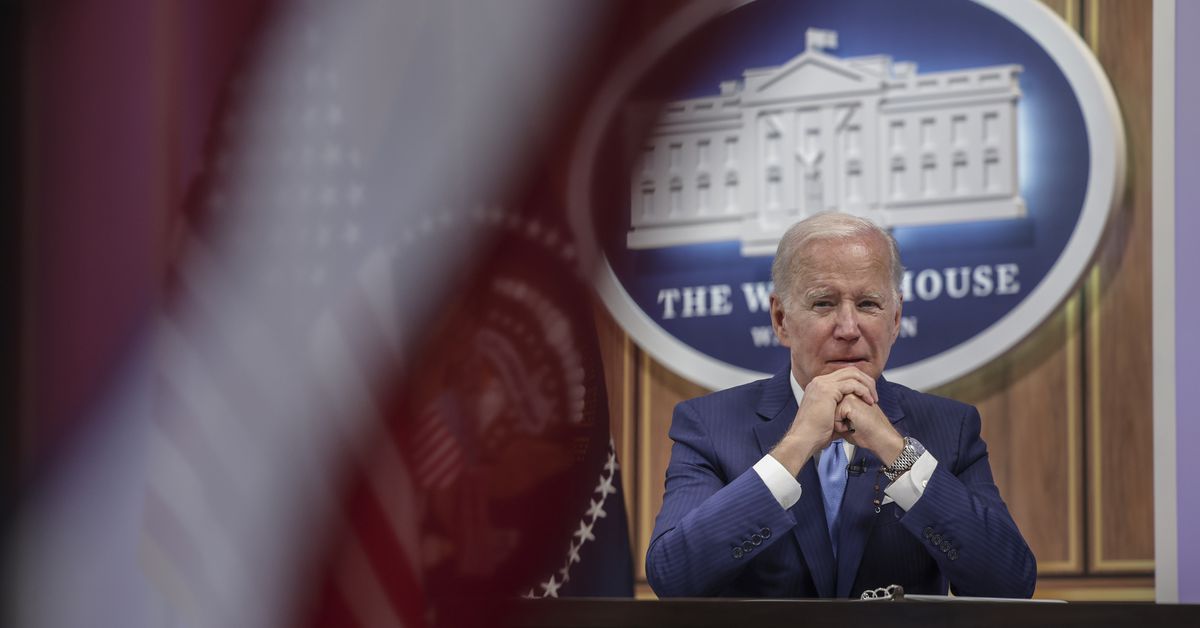Why Joe Biden is invoking a war power to build heat pumps and solar panels
President Joe Biden meeting virtually with baby formula manufacturers on June 1. He recently invoked the Defense Production Act to spur domestic production of clean energy technology. | Kevin Dietsch/Getty ImagesThe president is making clean energy a national security...

It looks like President Joe Biden is done waiting for Congress to do something about the country’s dependence on foreign energy. Through a series of executive actions announced on Monday, the president plans to use the Defense Production Act to boost clean energy in the United States by putting a two-year freeze on tariffs for solar panels coming to the country from Southeast Asia and simultaneously scaling up the domestic production of clean energy technologies.
This is the latest in a series of moves that show the White House is beginning to treat climate change and clean energy as national security issues. It’s also the kind of thing climate activists have been asking the Biden administration to do for months. The executive actions could bring thousands of manufacturing jobs to the country while also making the US less dependent on foreign oil and gas, particularly as the war in Ukraine continues.
This week’s Defense Production Act (DPA) authorization specifically targets solar technology, heat pumps, insulation, green hydrogen, and grid components like transformers. Those might not seem very similar to, say, repurposing automobile production lines to build tanks, but in the past few years we have seen the definition of national security shift to encompass more than just military spending. It now includes everything from the manufacture of equipment to treat Covid-19 to baby formula. Biden’s latest move sends a message that clean energy technologies are worth investing in because they are critical to the security of the country, and the government is willing to support their production even if the market would prefer cheaper imports.
“There are tons of things the defense industry does that, on their face, would not exist in a free market environment,” said Sarah Ladislaw, managing director of the US program at RMI, a clean energy think tank. “But they are important to the proper functioning of our economy in a way that is much more significant than just a commodity.”
It will take time for manufacturing to spin up in response to the DPA, which is why Biden’s executive order is also addressing tariffs on imported solar panels. A two-year freeze on tariffs for certain solar panel imports might sound like the kind of wonky finagling that’s best left for international economists to argue over, but experts say it’s the action that’s going to have the most immediate impact. That’s because the American solar industry has been in a state of generalized hysteria lately due to a Commerce Department investigation into whether developers were dodging tariffs on Chinese solar equipment by importing the equipment from four other Asian countries — Cambodia, Malaysia, Thailand, and Vietnam — instead. The investigation threatened to derail solar projects across the country, jeopardizing a burgeoning solar market that employed hundreds of thousands of workers.
“The tariffs thing is absolutely transformative,” said Leah Stokes, an associate political science professor at the University of California Santa Barbara. More than 230,000 people work in the American solar industry as of 2020, mostly in installation, and “the vast majority of those jobs depend on solar imports,” according to Stokes, who is also the senior policy counsel at the electrification nonprofit Rewiring America.
Hundreds of solar projects around the country had been put on hold in the last two months while developers waited to find out if they’d have to pay billions in tariffs. The newly announced freeze, however, should allow those projects to move forward immediately, while also giving American solar manufacturers time to ramp up production to meet the needs of future projects. That’s where the Defense Production Act will come in, using grants and loans to spur domestic solar manufacturing before the tariff freeze expires.
The DPA gives the White House the power to tell private companies what to manufacture for the sake of the country. Presidents Trump and Biden both used the act to bolster the country’s pandemic response, and Biden recently used the act to respond to the formula shortage and rising energy prices due to the war in Ukraine — the latter executive action also directed DPA funding toward critical minerals for the production of batteries. Paired with Monday’s authorization, that order could set up the country for a rise in both the supply of clean energy and batteries to store that clean energy in.
“It puts energy back into a place we haven’t been in a long time,” said Ladislaw. For decades, American energy policy has prioritized cheap energy, which opened the door to energy supply disruptions of the type seen during the 1973 oil crisis and the current rise in gas prices due to a ban on Russian oil. Biden’s DPA authorization puts the country on the path to energy independence and, according to Ladislaw, is a signal that the administration thinks of energy as “a strategic asset that has to be managed in a different way, instead of just letting the market handle it.”
Aside from solar manufacturing, the DPA authorization also includes funding to ramp up the production of four other technologies: green hydrogen technology, which can be used to store clean energy and clean up carbon-heavy industries; grid components like transformers, which will help build a more modern, resilient grid that can handle an influx of renewable energy; heat pumps, which use electricity to heat and cool homes more efficiently than fossil fuel-dependent systems like furnaces; and building insulation, which is an overlooked tool in fighting climate change, making homes more energy-efficient and keeping them heated and cooled for longer.
It’s an encouraging sign that the Biden administration is looking at energy holistically, focusing on efficiency and energy savings just as much as supply. Heat pumps, in particular, have been the focus of writers like Bill McKibben as well as electrification nonprofits. McKibben recently wrote that using the DPA to spur heat pump production could help alleviate the global impacts of the war in Ukraine while also reducing our climate impacts, and Rewiring America released a heat pump-focused policy plan to bolster American manufacturing and labor and reduce Europe’s reliance on Russian oil and gas.
While all of these steps are encouraging, the impact of the DPA is still limited by its budget — a few hundred million dollars — and by the fact that the authorization can easily be revoked. President Biden has increasingly needed to turn to executive action to achieve a sort of piecemeal resurrection of a climate agenda that has mostly faltered in Congress, but that’s not a long-term solution.
Republicans have also taken issue with Biden’s characterization of clean energy as a matter of national security worthy of the DPA. Sen. Pat Toomey (R-PA) attacked Biden on Twitter for using his executive order to “advance his global warming agenda,” suggesting Congress curtail the act if the administration “keeps misusing the DPA for non-defense purposes.” Toomey’s argument ignores both the Pentagon and the text of the Defense Production Act itself, however: A Defense Department report from last October found climate change was an issue of national security, and the text of the DPA itself lists energy as a “strategic and critical material.”
Lasting change, Stokes and Ladislaw said, has to come through Congress. The ghost of Biden’s Build Back Better bill, which is still winding its way through reconciliation, could unlock hundreds of billions of dollars in incentives, far more than the budget allocated to the DPA.
“Congressional action is really important,” Ladislaw said. “Our attention will shift on security matters and energy security and climate. So what Congress is doing is really necessary; they will be a much bigger deal in terms of impact in the long term. This is meant to be a complement to what the Hill can achieve.”
The question, of course, is whether the Hill can achieve anything on climate change. Toomey’s reaction is quite telling of the current atmosphere in Washington: A plan that increases American manufacturing jobs, whether through the Defense Production Act or through the Build Back Better Bill, would in any other circumstances be an easy bipartisan sell. The problem, it seems, is not the plan but the product. Clean energy and climate action appear to be automatic no-gos for Republicans, and until that changes, the planet — and American jobs — will simply have to suffer the consequences.
This story was first published in the Recode newsletter. Sign up here so you don’t miss the next one!

 FrankLin
FrankLin 




























.jpg)


